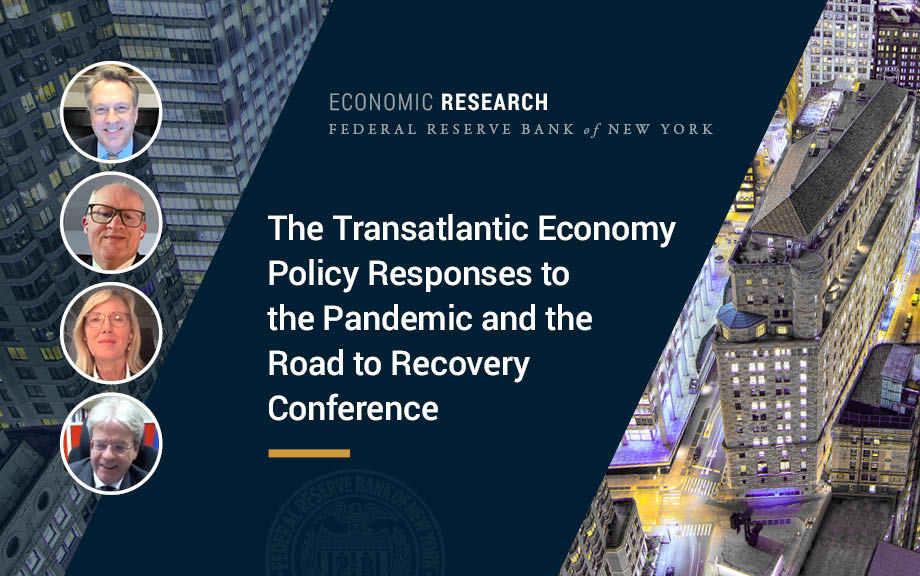Do Economic Crises in Europe Affect the U.S.? Some Lessons from the Past Three Decades

In this post we summarize the main results of our contribution to a recent e-book, “The Making of the European Monetary Union: 30 years since the ERM crisis,” on the economic and financial crises in Europe since 1992-93, and focus on the spillovers of those crises onto the United States and the global economy. We find that the answer to the question in the title of this post is a (moderate) yes.
The Transatlantic Economy Policy Responses to the Pandemic and the Road to Recovery Conference

The Federal Reserve Bank of New York, the European Commission, and the Center for Economic and Policy Research (CEPR) jointly organized the conference “Transatlantic Economic Policy Responses to the Pandemic and the Road to Recovery,” on November 18, 2021. The conference brought together U.S. and European-based policymakers and economists from academia, think tanks, and international financial institutions to discuss issues that transatlantic policymakers are facing. The conference was held before the Russian invasion of Ukraine and the global monetary tightening. Still, its medium to long-term focus provides interesting insights on economic policy challenges ahead.
How Have the Euro Area and U.S. Labor Market Recoveries Differed?

The initial phase of the pandemic saw the euro area and U.S unemployment rates behave quite differently, with the rate for the United States rising much more dramatically than the euro area rate. Two years on, the rates for both regions are back near pre-pandemic levels. A key difference, though, is that U.S. employment levels were down by 3.0 million jobs in 2021:Q4 relative to pre-pandemic levels, while the number of euro area jobs was up 600,000. A look at employment by industry shows that both regions had large shortfalls in the accommodation and food services industries, as expected. A key difference is the government sector, with the number of those jobs in the euro area up by 1.5 million, while the government sector in the United States shed 600,000.
The Global Supply Side of Inflationary Pressures

U.S. inflation has surged as the economy recovers from the COVID-19 recession. This phenomenon has not been confined to the U.S. economy, as similar inflationary pressures have emerged in other advanced economies albeit not with the same intensity. In this post, we draw from the current international experiences to provide an assessment of the drivers of U.S. inflation. In particular, we exploit the link among different measures of inflation at the country level and a number of global supply side variables to uncover which common cross-country forces have been driving observed inflation. Our main finding is that global supply factors are very strongly associated with recent producer price index (PPI) inflation across countries, as well as with consumer price index (CPI) goods inflation, both historically and during the recent bout of inflation acceleration.
The Overnight Drift in U.S. Equity Returns

Since the advent of electronic trading in the late 1990s, S&P 500 futures have traded close to 24 hours a day. In this post, which draws on our recent Staff Report, we document that holding U.S. equity futures overnight has earned a large positive return during the opening hours of European markets. The largest positive returns in the 1998–2019 sample have accrued between 2 a.m. and 3 a.m. U.S. Eastern time—the opening of European stock markets—and averaged 3.6 percent on an annualized basis, a phenomenon we call the overnight drift.
What Is behind the Global Jump in Personal Saving during the Pandemic?

Household saving has soared in the United States and other high-income countries during the COVID-19 pandemic, despite widespread declines in wages and other private income streams. This post highlights the role of fiscal policy in driving the saving boom, through stepped-up social benefits and other income support measures. Indeed, in the United States, Japan, and Canada, government assistance has pushed household income above its pre-pandemic trajectory. We argue that the larger scale of government assistance in these countries helps explain why saving in these countries has risen more strongly than in the euro area. Going forward, how freely households spend out of their newly accumulated savings will be a key factor determining the strength of economic recoveries.
Is Stigma Attached to the European Central Bank’s Marginal Lending Facility?

The European Central Bank (ECB)’s marginal lending facility has been used by banks to borrow funds both in normal times and during the crisis that started in 2007. In this post, we argue that how a central bank communicates the purpose of a facility is important in determining how users of the facility are perceived. In particular, the ECB never refers to the marginal lending facility as a back-up source of funds. The ECB’s neutral approach may be a key factor in explaining why financial institutions are less reluctant to use the marginal lending facility than the Fed’s discount window.
At the N.Y. Fed: The Transatlantic Economy: Convergence or Divergence?
On April 18, 2016, the New York Fed hosted a conference on current and future policy directions for the linked economies of Europe and the United States. “The Transatlantic Economy: Convergence or Divergence,” organized jointly with the Centre for Economic Policy Research and the European Commission, brought together U.S. and Europe-based policymakers, regulators, and academics to discuss a series of important issues: Are the economies of the euro area and the United States on a convergent or divergent path? Are financial regulatory reforms making the banking and financial structures more similar? Will this imply a convergence in macroprudential policies? Which instruments do the United States and the euro area have at their disposal to raise investment, spur productivity, and avoid secular stagnation? In this post, we summarize the principal themes and findings of the conference discussion.
Counterparties and Collateral Requirements for Implementing Monetary Policy

What types of counterparties can borrow from or lend to a central bank, and what kind of collateral must they possess in order to receive a loan? These are two key aspects of a central bank’s monetary policy implementation framework. Since at least the nineteenth century, it has been understood that an important role of central banks is to lend to solvent but illiquid institutions, particularly during a crisis, as this provides liquidity insurance to the financial system. They also provide liquidity to markets during normal times as a means to implement monetary policy. Central banks that rely on scarcity of reserves need to adjust the supply of liquidity in the market, as described in our previous post[add link]. In this post, we focus on liquidity provision related to the conduct of monetary policy .
Do Asset Purchase Programs Push Capital Abroad?
Thomas Klitgaard and David O. Lucca Euro area sovereign bond yields fell to record lows and the euro weakened after the European Central Bank (ECB) dramatically expanded its asset purchase program in early 2015. Some analysts predicted massive financial outflows spilling out of the euro area and affecting global markets as investors sought higher yields […]










 RSS Feed
RSS Feed Follow Liberty Street Economics
Follow Liberty Street Economics